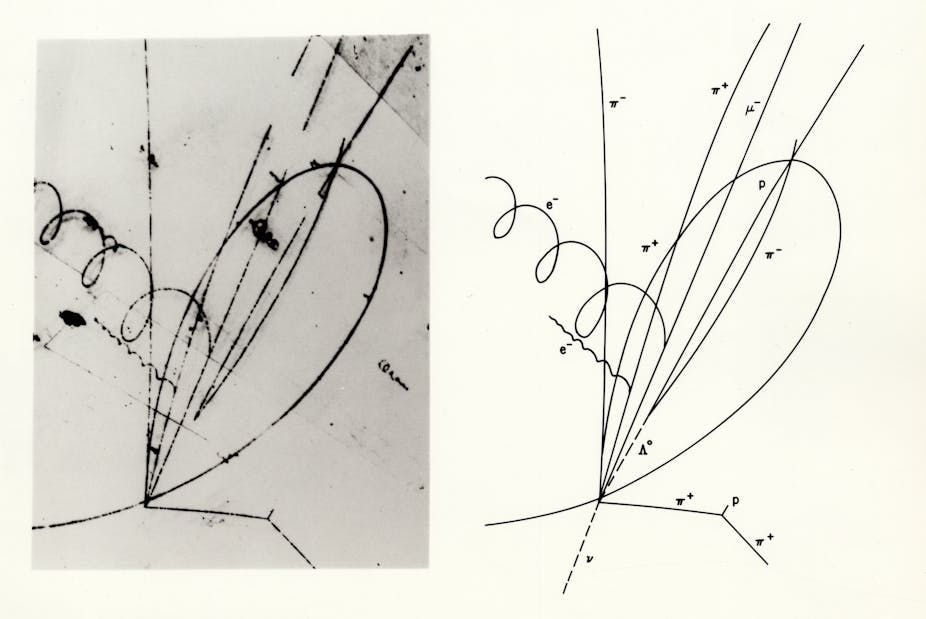Since the spectacular discovery of the Higgs boson in 2012, physicists at the Large Hadron Collider (LHC), the gigantic particle accelerator outside Geneva, have suffered a bit of a drought when it comes to finding new particles. In a welcome relief, the LHCb collaboration, who run one of four large experiments at the LHC, have announced one of the most genuinely exciting observations to come out of the 27km super-collider so far – an exotic particle that cannot be explained by current theories.
In the early 1930s physicists had a clean picture of the subatomic particles that make up our world. Every known atom has a tiny nucleus at its heart surrounded by a cloud of electrons, and each nucleus was made out of varying numbers of protons and neutrons. However, as the decades wore on a number of new, and somewhat unwelcome, particles were discovered, at first in detectors studying particles from outer space and later in particle-collider experiments.
By the 1950s, dozens of apparently elementary particles had been discovered, causing frustration among physicists who often brandish an inability to memorise a list of facts as a badge of honour. The famous physicist Enrico Fermi perhaps best expressed the mood of his colleagues in an infamous remark:
“Young man, if I could remember the names of these particles, I would have been a botanist.”
Help came in the 1950s when physicists came up with a new model that explained most of these particles as being made up of a small number of truly elementary particles. Borrowing a line from James Joyce’s Finnegans Wake (a book that is even harder to understand than quantum field theory), Murray Gell-Mann dubbed these new particles “quarks”.
By the late 1960s the existence of quarks had been verified experimentally. We now know that there are six in total – the up, down, strange, charm, bottom and top quarks, along with six antiquarks (their anti-matter copies).
The quark model neatly explained all these peculiar particles. Protons, neutrons and many others besides are made of three quarks, belonging to a family known as baryons. Alternatively, a quark and an antiquark can pair up to form a meson.
Since then the quark model has been extremely successful, and is now a cornerstone of our understanding of particle physics. It was only at the turn of the millennium that some strange results started to suggest that the model might be incomplete. Until 2003 quarks had only been seen in twos or threes, but then a number of particles that looked like combinations of four quarks started to reveal themselves.
In 2008 the Belle Collaboration in Japan reported the observation of a new exotic particle – the unfortunately drably named Z(4430)– (where – for its negative charge). This has a mass that places it in a dense forest of charmonium states – particles that are made up of a charm quark and a charm antiquark. Crucially though, the Z is electrically charged whereas all charmonium states must be neutral, clearly marking it out as something unusual.
After a careful analysis of data from 25,000 decays of mesons resulting from more than 180 trillion collisions at the LHC in 2011 and 2012, the new announcement confirms the existence of Z(4430)– with extremely high confidence. The particle was observed with an overwhelming significance of 13.9 sigma, well above the usual 5 sigma threshold required to declare a discovery. LHCb also went further than Belle by measuring the spin and parity of Z(4430)–, two quantum-mechanical properties that give a firm handle on the internal makeup of the particle.
The observation by LHCb is important because few physicists will take a result seriously until it has been seen by two independent experiments. This is why hundreds of millions of Euros were spent building two large detectors at the LHC. The observation of the Higgs boson by two independent teams, ATLAS and CMS, was what really convinced the scientific community that the particle was real.
This result is the clearest evidence yet of the existence of a tetraquark – a four-quark state, with the LHCb analysis suggesting that Z(4430)– is most likely to be made of a charm, anti-charm, down and anti-up quark. Theorists are now able to add a whole new type of particle to the quark model and begin the hard work of trying to understand exactly how these four quarks are bound together.
Meanwhile, physicists working at the LHC experiments will continue to explore unmapped regions of the subatomic world, with the hope of turning up more members of this exotic new family. Now that we know that at least one is out there, it is very unlikely that Z(4430)– is alone.

